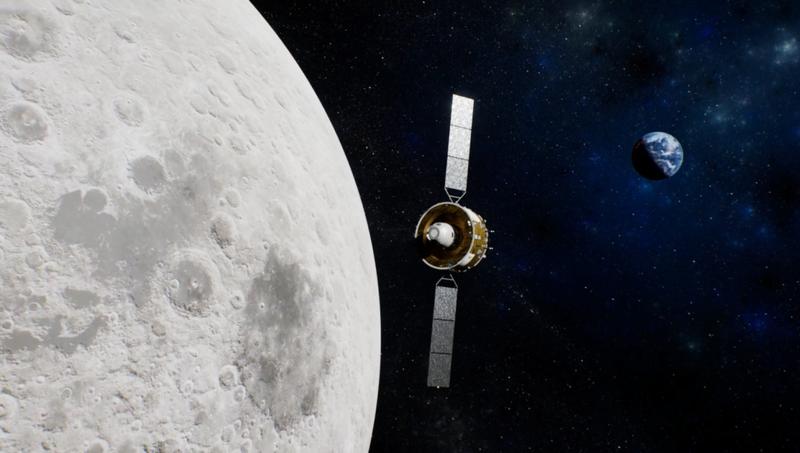 An illustration shows the orbital transfer injection by Chang'e 5's orbiter-reentry capsule combination. (PHOTO PROVIDED TO CHINA DAILY)
An illustration shows the orbital transfer injection by Chang'e 5's orbiter-reentry capsule combination. (PHOTO PROVIDED TO CHINA DAILY)
The orbiter-reentry capsule combination of China's Chang'e 5 robotic probe carried out its first moon-Earth transfer injection maneuver on Saturday morning, placing itself in an elliptical lunar orbit, according to China National Space Administration.
The combination had been traveling in a near-circular lunar orbit for nearly six days before conducting the maneuver, which is intended to enable the spacecraft to shift toward a moon-Earth transfer trajectory, the administration said in a statement.
It added that the combination will perform a second injection in due course to get away from the moon's gravity and finally enter its trajectory back to Earth.
There are about 2 kilograms of lunar rocks and soil contained inside the reentry capsule.
After arriving in an Earth orbit, the pair will break up in due course, and the reentry capsule will conduct a series of complicated maneuvers to return to a preset landing site in North China's Inner Mongolia autonomous region in mid-December.
After arriving in an Earth orbit, the pair will break up in due course, and the reentry capsule will conduct a series of complicated maneuvers to return to a preset landing site in North China's Inner Mongolia autonomous region in mid-December
ALSO READ: Chang'e-5 unfurls China's national flag on moon
Chang'e 5, China's largest and most sophisticated lunar probe, has four main components-an orbiter, lander, ascender and reentry capsule. The spacecraft was launched by a Long March 5 heavy-lift carrier rocket early on Nov 24 at the Wenchang Space Launch Center in South China's Hainan province, setting out on China's most challenging lunar adventure and the world's first mission since 1976 to bring lunar samples back to Earth.
The probe separated into two parts-the orbiter-reentry capsule combination and the lander-ascender combination - while in lunar orbit early on the morning of Nov 30.
Late on Dec 1, the lander-ascender combination landed on the moon, becoming the world's third spacecraft to touch down on the lunar surface this century after its predecessors – Chang'e 3 and 4. Shortly after landing, the duo soon began to use a drill to obtain underground samples from 2 meters beneath the surface.
It finished the underground operation early on the morning of Dec 2, and then started to use a mechanical arm to scoop up surface dirt.
All collection and packing processes finished at night that day, much sooner than expected. Samples were packed into a vacuum container inside the ascender.
The ascender activated an engine late on Dec 3 to lift itself into an elliptical lunar orbit to prepare for docking with the reentry capsule, marking the first time a Chinese spacecraft has blasted off from an extraterrestrial body.
It rendezvoused and docked with the orbiter-reentry capsule combination early on Sunday morning and then transferred lunar samples into the capsule.
READ MORE: Orbiter-returner combination of Chang'e-5 splits from ascender
The operation is the first automated rendezvous and docking for any spacecraft in a lunar orbit.
The last time two components of a spacecraft rendezvoused and docked with each other in lunar orbit took place in December 1972 during the last Apollo mission, and that was monitored and controlled by astronauts.
The ascender then separated from the combination. It was commanded to impact on the moon on Tuesday morning.
If successful, the highly sophisticated Chang'e 5 mission would be the first in more than 40 years to bring lunar samples back to Earth, and will make China the third country to do so after the United States and the former Soviet Union.


